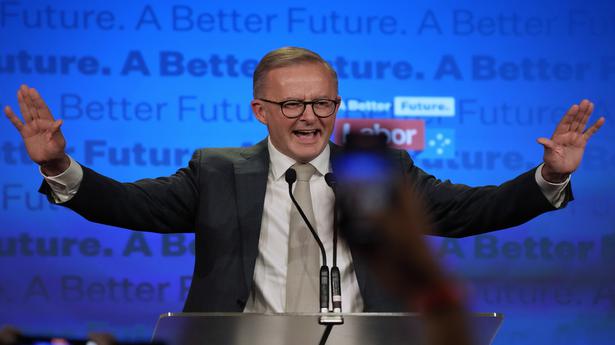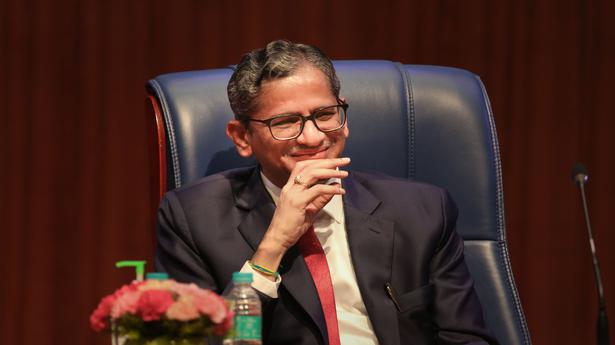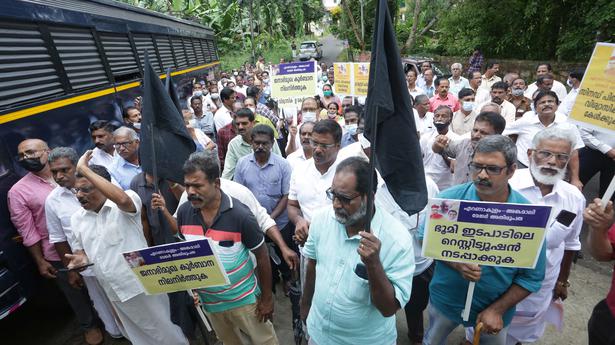Australia’s newly elected Prime Minister Anthony Albanese promised many ‘firsts’, including greater representation for women and indigenous people. What particularly worked were his assertions of ensuring ‘full employment’, upscaling health access and combating climate change
Australia’s newly elected Prime Minister Anthony Albanese promised many ‘firsts’, including greater representation for women and indigenous people. What particularly worked were his assertions of ensuring ‘full employment’, upscaling health access and combating climate change
The story so far: Australia’s first ‘non-Anglo Celtic’ Labour Party leader Anthony Albanese assumed the Prime Minister’s office on Monday, bringing an end to the nine-year rule of Scott Morrison’s Liberal Party-led coalition. Following the electoral victory, he said, “Thank you for this extraordinary honour, tonight the Australian people have voted for change.”
During his campaign, the Member of Parliament had touched upon issues pertaining to climate change, improving social services, integration of communities and tackling corruption. Particularly noteworthy was Mr. Albanese’s commitment to adopt the ‘Uluru Statement from the Heart’ in full. He opened his victory speech acknowledging the “traditional owners of the land on which we meet”.
The Uluru statement, signed by representatives of varied indigenous groups in 2017, sought constitutional reforms to empower the First Peoples of Australia. Mr. Albanese spoke about bringing in a referendum to create an indigenous advisory body to the federal parliament to make their voices heard.
The Labor Party also affirmed its commitment to establish the long-pending anti-corruption regulator, ‘Integrity Commission’, that was first announced in December 2018. Its plan involves instituting a National Anti-Corruption Commission which would be in stark contrast to the “universally condemned model for an integrity commission”.
Mr. Albanese’s stance on ending ‘climate wars’, upscaling health access, ensuring ‘full employment’, gender parity at workplaces and reducing the cost of living reportedly found a lot of takers. Some of them were a noticeable departure from the policies of the outgoing Coalition.
Housing and childcare
Mr. Albanese has often talked about his early years, living in public housing with his single mother, who was on a disability pension. “It’s where I learned the value of community, the value of a dollar and the value of holding no one back and leaving no one behind,” he said.
During his campaign, the Labor leader said many parents were forced to resign from their jobs or were unable to put in extra hours because of an unreliable child care system and expensive early learning. This, he says, results in children either missing out on important early learning and/or women being unable to work.
He proposed increasing the maximum child care subsidy rate to 90% for the first child in care, and providing additional subsidies to families earning less than $530,000 annually. Further, there would be higher subsidies for the second and additional children in care. In comparison, the Coalition spoke about having ensured 90% Australian families avail subsidies between 50% and 85%, extending up to a maximum 95%.
Australian public policy think-tank Grattan Institute argues that the Labor’s policy is “broader”. “As well as helping families with two or more children in care, Labor’s policy also increases the subsidy for a family’s first child in care,” it stated.
Among the many firsts, Labor also spoke about introducing legislation that would give women 10 days of paid leave, and provide safe and affordable housing to those fleeing domestic or any other violence. Of the 20,000 social housing properties being planned for the initial five years, 4,000 would be allocated to women and children at risk of homelessness.
Mr. Albanese also professed his commitment in implementing all 55 recommendations of the 2020 ‘Respect@Work’ report, aimed at tackling sexual harassment at workplaces. He also assured the narrowing of the gender pay gap especially in low-paid, female-dominated industries. As per the Australian Government’s Workplace Gender Equality Agency (WEGA)’s data, women were earning $255.30 less per week than men.
Healthcare
The Labor Party’s healthcare system would address issues in two realms: old-age care and the publicly-funded health insurance scheme, Medicare. Mr. Albanese stated that all Australians deserve access to universal, prompt and world-class medical care, and vital treatments must not be delayed because of affordability.
“Labor built Medicare and we will always protect it,” he had said.
The party aspires to install at least 50 Medicare Urgent Care Clinics across the country. The clinics would cater to urgent but not life-threatening need for care free of cost for Medicare beneficiaries. The size and nature of these clinics would vary as per local needs, aiming to reduce dependency on hospital emergency departments. The Labor Party intends to invest about $135 million over four years for the same.
According to a report in The Guardian, both parties spoke about reducing the Pharmaceutical Benefits Scheme co-payment (percentage of the claim amount to be paid by the policyholder from his own pocket in a health insurance policy) to bring down the cost of medicines.
According to Grattan, nearly half a million Australians decided not to see a specialist because they could not afford it, some even deferred or did not fill their prescriptions for the same reason. Bulk billing rates are too low resulting in greater out-of-pocket payments. “It is a Catch-22 situation: the people who need the most healthcare—the poor and the chronically ill—miss out on care the most. That is obviously bad for the people, but it’s also bad for taxpayers, because when people defer recommended treatment, they often get sicker and end up in hospital,” it states.
For old-age care, Labor plans to introduce jail time for “dodgy aged-care providers” and empower the Aged Care Quality and Safety Commission with more investigative powers. Its five-point plan mandates the requirement of a registered nurse at every facility 24/7, ensuring 215 minutes of direct care each day, pay-rise for workers, better food for residents and increasing transparency in the entire system through enhanced reporting measures. The central premise is to lift wages in the sector, deliver better care and improve transparency and accountability.
Commitment to climate change
Mr. Albanese’s Labor Party aspires to reduce emissions by 43% by 2030, higher than the Morrison government’s reduction of 26-28%. The Guardian stated that though the Coalition suggested reaching net zero emissions by 2050, it did not work out how to reach the targets. However, the outgoing party professed investments worth more than $22 billion in low emissions technologies, bringing the total till date to $88 billion. The strategy involved reducing emissions while letting the economy grow and creating more jobs across the country.
Labor intends to invest an additional $194.5 million in reef protection programs on top of existing programs, computing the total investment to almost $1.2 billion by 2030. In addition to protecting the reef, the Labor Party intends to protect the 64,000 jobs that rely on it through climate action initiatives, catchment restoration and protecting the Reef’s threatened species. The Coalition, in this year’s budget, had further strengthened its Reef 2050 Sustainability Plan with an additional $1 billion, with total investments to date exceeding $3 billion. The plan is aimed at improving water quality, fighting crown of thorns starfish and conducting research into reef restoration and adaptation. Labor Party’s plan also involve doubling the funding for the Reef 2050 Plan and continue the program scheduled to end in 2023. As a first, it spoke of deploying ‘indigenous rangers’ a lead role in reef preservation.
The incoming outfit also spoke about fixing up waterways and catchments to ensure a better quality of living for people around it. Its plan for urban rivers and catchments, according to them, would protect species like the Regent Honeyeater, the Curlew Sandpiper, the Koala, several species of frogs and the loggerhead turtle. Its $200 million program is expected to fund as many as 100 such projects depending on their size.
Tax relief and jobs
Mr. Albanese said he would embark on legislative tax cuts that would benefit more than nine million Australians with incomes above $45,000. Further, his plan would involve supporting the cost of living through an increase in the low-and-middle income tax offset by $420 this year.
He aspires to endow focus on meaningful investments for “maximum economic impact and community need”, reducing waste and rorts, ensuring multinationals pay their fair share of taxes and strengthening the post COVID-19 economy. In contrast, the Morris government stated it would not introduce any new taxes for Australian workers, retirees, superannuation, small businesses and for housing and electricity. It proposed to deliver an additional $100 billion of permanent tax relief over the next four years. A mention about multinationals paying their fair share of taxes also found space in his pre-poll assertions.
On the employment front, the Coalition government’s plan was to create 1.3 million jobs over the next five years by providing tax reliefs for workers, investment incentives for businesses, subsidising apprenticeships, boosting skills and diversifying the economy.
The Labor Party did not put forth any such figure, instead, spoke about ensuring ‘full employment’, meaning not only fewer people unemployed, but also secure jobs that provide sufficient hours of work, is non-discriminatory and ensures participation of women, the indigenous people and those with disability. Its plans include extending power of the Fair Work Commission to set minimum standards for ‘‘new forms of work’’, such as gig work. It would ensure that gig workers have access to entitlements and protections denied to them by existing laws. Further, it aspires to legislate a fair and objective test to determine whether workers can be classified as ‘casual’, in order to ensure that they have a clearer pathway to permanent work.
The Labor Party matches its competitors’ apprenticeship programmes by suggesting the introduction of Fee Free TAFE (Technical and Further Education) to help rebuild industries hit hardest by the pandemic, such as hospitality and tourism, in addition to meeting the current and future needs in the care economy, including jobs like child care, aged care, disability care, nursing and community services. “Labor will end privatisation by stealth, ensuring at least 70 per cent of Commonwealth vocational education funding is for public TAFE,” it said.





